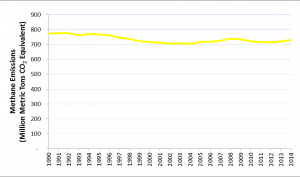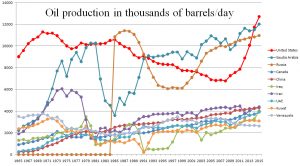Article in Skeptic.
I enjoyed another talk with Chris Irons on the Quoth the Raven podcast. We talked about the impact of Biden’s policies on US oil production, and how his actions are seriously damaging the US economy.
Quoth the Raven link to the podcast. You can also download it from the link.
The podcast is summarized here:
Biden’s Oil Policies Are “Bat-Shit Crazy”, Creating “Turmoil” In Markets: USF Geology Professor Dr. Marc Defant – link
The US has become the largest producer of oil and gas in the world because of the technology created in 1997 to produce oil shales via fracking. The talk by Marc Defant was given on May 17, 2021 to the Rotary Club. Defant’s message is that we need to be good stewards of the environment but not destroy our economy by quickly converting to clean energy.
I enjoyed another talk with Chris Irons on the Quoth the Raven podcast. We talked about the New York Post article and the duplicity of the Press and even got into some discussions about global warming, volcanoes, and existential threats.
Quoth the Raven link to the podcast. You can also download it from the link.
When the World Trade Center was being built in 1973, Dr. Irving Selikoff, an expert on asbestosis and cancers caused by asbestos, was an outspoken critic of the wholesale spraying of the floors of the two structures with insulator containing copious quantities of asbestos for fire-proofing. He knew the potential dangerous hazards of asbestos as did the asbestos industry. Fortunately not all floors were insulated because New York City instituted a ban on the spraying of asbestos in the same year. Fast forward almost 30 years when the plumes of dust rolled over lower Manhattan after the collapse of the World Trade Center towers on 9/11. The brave souls that rushed to help survivors and participate in the cleanup along with the many people that lived and worked in the area were exposed to one of the most serious carcinogens ever documented – asbestos in its many forms. One of the most deadly results of inhaling the tiny asbestos fibers that permeated the World Trade Center clouds is the nearly always fatal cancer mesothelioma (known to be caused only by asbestos). Unfortunately, the cancer often shows up decades after exposure. What many people do not realize is that asbestos has still not been banned in the United States even though the asbestos community has known internally since at least the 1930s that it was not only harmful but deadly. The asbestos executives and their hired doctors promulgated a disinformation campaign that asbestos was and is harmless knowing full well that these claims were patently wrong1.
Selikoff first came to prominence in 1964 when he organized an international symposium on the “Biological Effects of Asbestos” through the New York Academy of Sciences. Selikoff, through his position as the director of the Environmental Sciences Laboratory at the Mount Sinai Hospital in New York, was able to persuade the International Association of Heat and Frost Insulators & Asbestos Workers union to provide him with workers’ medical profiles2. He presented four papers at the conference on the results of his epidemiological studies of the union workers. There was no mistaking his results — working with asbestos insulation caused an increase in death by 25 percent from not only mesothelioma but asbestosis, lung cancer and even cancers of the stomach, colon and rectum. His independent research could not be buried by the asbestos industry as they had with their subsidized research, and Selikoff’s results were reported widely in the press. Selikoff’s team even found that insulator workers who smoked were ninety times more likely to get some form of asbestos-related cancer than those workers that did not smoke.
I don’t want to appear sanctimonious, but the dangers due to asbestos Selikoff and others reported in 1964 should have caused the asbestos industry pause – maybe even force them to attempt to improve working conditions. But as in other industries with similar threats, the asbestos executives circled the wagons and then went on the offensive. The Asbestos Textile Institute’s lawyers (the asbsetos industry’s public relation’s arm to promote asbestos products) sent letters to the New York Academy of Sciences and Selikoff warning them about the impact of their “damaging and misleading news stories”. Their smear campaigns began by attacking Selikoff’s medical credentials and the quality of his work. For years, the asbestos industry stalked Selikoff and others at conferences and meetings attempting to undermine their work. More details can be found in Jock McCulloch and Geoffrey Tweedle’s outstanding book entitled Defending the Indefensible: The Global Asbestos Industry and its Fight for Survival.
It is astounding the lengths the asbestos industry went to suppress information they deemed adverse and to circulate disinformation cranked out by their hired doctors and researchers. Asbestos executives also turned to the largest public relations firm in the world – Hill & Knowlton – a sort of hit squad of lawyers with a ubiquitous presence in undermining science damaging to their clients which included Big Tobacco3. But perhaps what can only be described as turpitude, the companies led the disinformation campaigns while laborers in a whole slew of industries from mining to textiles worked in deplorable conditions that caused sickness and death. In the Libby mine in Montana, for example, not only was fibrous asbestos dust so thick in some areas of the open-pit mine it was hard for workers to see each other. The dust blew into the nearby town causing asbestos illness and death to residents (the Libby mine was eventually closed due to the huge number of tort claims by families struck by illness and death related to the operations). It was common for the industry to fire workers that developed asbestosis or cancer to avoid the appearance of illnesses related to asbestos. When it became clear to the industry that mesothelioma was a serious public relations nightmare, their public relation’s machine went into full overdrive focusing on two strategies. 1) Reassuring people that asbestos-related diseases were caused only by the inhalation of large amounts of fiber dust over long periods of time (internal memorandums clearly show that the companies involved knew this was not true). 2) Foisting the argument on the public that mesothelioma was the result of blue asbestos and that other types of asbestos, such as chrysotile, were safe (once again, internal memorandums show that the companies knew this to be patently untrue).
The diagram below shows the world production numbers for asbestos from 1900 through 2015. One might think that the asbestos industry would have been crippled by Selikopf’s research reported in 1964. But production actually increased through the 1960s and went on increasing into the late 1970s before tort claims began to impact the industry. But even today, worldwide production has not decreased below the early 1960s output due mostly to production in developing nations. The diagram is a testimonial to the success of the asbestos industry’s ability to undermine solid scientific research with political clout and the financial resources to promote their agenda – asbestos is safe. We have seen the same thing in many other industries like Big Tobacco with smoking and Exxon with global warming. McCulloch and Tweedle make a salient point: “Put another way, nearly 80 per cent [sic] of world asbestos production in the twentieth century was produced after the world learned that asbestos could cause mesothelioma!”
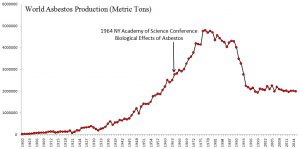 Data from Virta4 for 1900 through 2003, Virta for 2004 through 2006 (consumption), and Statista for 2007 through 2015.
Data from Virta4 for 1900 through 2003, Virta for 2004 through 2006 (consumption), and Statista for 2007 through 2015.
Imagine that you are the mayor of a small town dependent on tourism, and doctors in the village are reporting an outbreak of a bacterial disease that is killing 40 percent of those being infected. You decide that reporting the disease to the CDC or WHO would harm the financial health of your town and you seek to suppress the seriousness of the outbreak. You tell tourists they have nothing to worry about and chastise the local news affiliates by telling them they are acting hysterically and causing undue panic. Would anyone deny that you are guilty of a serious criminal act? This is essentially what the asbestos industry did over many decades, and yet no one in the asbestos industry has served a day jail time for their actions. In fact, they were so successful in their disinformation campaign that even today as mentioned above asbestos is not banned in the US even though cheap substitutes exist and asbestos has been banned in other industrial nations such as France and Britain. I asked Dr. Jock McCulloch why and his response is telling: “There is no easy answer to your question nor to the adjacent one as to why 2 million tons of asbestos will be mined and used globally during 2016. One of the key factors has been the corporate corruption of the science (which began in the 1930s) and the other is the baleful behaviour of Canada at international forums- due in the main to federal/Quebec politics. And then there is Russia, its political climate and anti-western reflexes.” Both Canada and Russia have been and are huge producers of asbestos and Canada with the help of scientists at McGill University funded by the asbestos industry (one of the reasons why scientists should remain independent in their research) has been instrumental in persuading other governments to act gingerly against asbestos interests.
Distressing research now shows that trivial exposure to asbestos can cause cancers. The Harvard paleontologist Stephen Jay Gould died of cancer caused by asbestos fibers perhaps from asbestos within ceiling tiles. Actor Steve McQueen died at the age 50 from mesothelioma probably from asbestos exposure when he worked in a break repair shop (breaks are lined with asbestos). Many instances of cancer among family members of miners and other laborers in the asbestos industry have been attributed to exposure to asbestos fibers brought home on clothing. I think about the lives destroyed by asbestos when I read the words of McCulloch and Tweedle: “Central to the strategy was a policy of concealment and, at times, misinformation that often amounted to a conspiracy to continue selling asbestos fibre irrespective of the health risks.” I might add that attempts to force the asbestos industry to warn their workers about the dangers of asbestos were averted. And although most mining and manufacturing has moved out of industrialized nations, the developing world has picked up the slack — places like Swaziland where laborers have few protections and little legal recourse for compensation from asbestos illnesses. Records through litigation have turned up showing that industry officials thought black workers were far less sophisticated than those in the US or Europe about hazards to their health and sought to take advantage of them.
 Stephen Jay Gould
Stephen Jay Gould  Steve McQueen
Steve McQueen
Sadly, the large asbestos companies (18 in all) were able to avoid paying thousands of tort claims in the US by declaring bankruptcy through Chapter 11. Bankruptcy implies that a company is insolvent, but due to the Manville Amendment passed by Congress in 1994 to help the asbestos industry, companies only need to show that future liabilities exceed the assets of the company in order to declare bankruptcy. The insurance companies pulled a similar “fast one” by shuttling liabilities into shell companies that also declared bankruptcy. I am very much for free and open trade but companies should be held responsible for travesties, and the bankruptcy claims are tantamount to highway robbery in my humble opinion. Many of those who lost out on benefits and claims were already on the edge of poverty from unemployment and the medical costs from their ailments. I might also point out that the American taxpayer is the ultimate source of support to these workers and their families because the asbestos companies were able to weasel their way out of their responsibilities to their employees and/or those harmed by their products. It may be important to remind the reader that it is estimated that between 15 to 35 million homes contain Libby asbestos as insulation. Asbestos is a problem that is not going away quickly.
I understand that industries like asbestos employ a large number of people (at one time in the 1960s, more than 200,000 people worked in the asbestos industry) and many of these workers would have difficulties finding new jobs elsewhere if the industries were closed overnight. But there are various steps that should be taken based on what we have learned from the asbestos travesty when future industries are found to be responsible for harm to their workers. 1) It should be a crime to purposely mislead the public and/or workers on safety issues of products. This must include the purposeful undermining of peer-reviewed science. The penalties should be stiff and include jail time. Laws need to be enacted accordingly. 2) Workers and their families need to be informed of the dangers in clear language in order that they may decide whether they wish to take the risk of continued employment in the industry. 3) In cases like asbestos where it is clearly a dangerous hazard, the product should be phased out by substitution of other products and eventually banned. 4) Workers and those impacted by the product should be entitled to compensatory damages through the establishment of funds in negotiations with the government. 5) And finally, American companies should be prohibited from moving their operations to nations that have lax laws that permit workers to be exposed to the hazardous products. If corporate America can’t police itself (and I don’t think they can based on the tales of woe involving tobacco, pesticides, global warming, etc.) the government must step in.
- McCulloch, J. and Tweedale, G. (2008) Defending the Indefensible: The Global Asbestos Industry and its Fight for Survival: Oxford University Press ↩
- Selikoff recruited Dr. E. Cuyler Hammond who had already published his landmark research on the link between smoking and lung cancer ↩
- Oreskes, N. and Conway, E. M. (2010) Merchants of Doubt: Bloomsbury Press ↩
- Virta, R. L. (2006) Worldwide Asbestos Supply and Consumption Trends from 1900 through 2003: USGS Circular 1298 ↩
The term fracking conjures up so many knee-jerk-bad reactions that I am hesitant to broach the subject. I suppose if I am going to wade into the topic I should give some bona fides to display my knowledge of the petroleum industry, but not too many bona fides so that I might be seen as a talking wonk for the gas industry. I worked for one year as an engineer for a well service company called Schlumberger (world’s largest) and two as a geologist with Shell Oil. Shell gave its geologists full responsibility for drilling a well from the time it was proposed to production if it hit oil. Of the 11 wells I proposed, 3 hit oil which was above the industry standard in producing fields in the late 1970s and early 1980s. Eventually I realized my calling was in teaching and research and left to go back to school for my PhD. But not before I got a pretty good idea of how the industry works.
The process of drilling is not complicated although the devil can be in the details. A rig contains strings of thirty-foot drill pipe which attach to a tri-cone tungsten carbide bit (see the image below). The bit spins from drives or motors as drilling fluid, called mud (contents vary but clay, water and lubricants are typical), is pumped through the pipe string to keep the bit cool, increase pressure, and bring the rock debris from drilling back to the surface along the outside of the pipe. One of the technological marvels developed in modern times is the ability to direct the drill bit to specific locations with pin-point accuracy by knowing where the bit is in three-dimensional space usually thousands of feet below the surface. Directional survey measurements are complex but are based on measurements while drilling through various instruments. These advances have enabled horizontal drilling which has become important in fracking.
 Rama, Wikipedia
Rama, Wikipedia
I would be remiss not to emphasize the importance given to protecting the water table when drilling. State and Federal regulations require the well to be sealed off at least 50 feet below where potable groundwater can be produced, and those laws have been in place as far back as anyone can remember. The drill pipe is tripped (pulled completely out of the hole) when regulators deem the surface casing should be set to protect the water table (something on the order of 500 feet usually). The casing is cemented in place, and if it is done correctly, we know from the drilling of hundreds of thousands of wells over many decades that the water table is protected. After the surface casing is set, drilling is continued until the target zone is reached. The pipe is tripped again and the entire well is generally set with cemented production casing. The hole is plugged at the bottom usually up to 50 feet below the horizon of interest. The casing is perforated by tools that blow holes in it precisely where the rock containing oil and/or gas exists. Lisa Margonelli has written an excellent book entitled Oil On the Brain about the details of drilling and its impact on the politics of many countries like Nigeria and Venezuela1.
When I worked for Schlumberger, it was my job to determine if production casing should be set by running tools in the hole. The measurements produced records called well logs that gave us information about not only the rock below but whether it contained producible oil or not. Drilling is a chancy business, not for the faint of heart. Most wells never produce a drop of oil. I have seen many an owner of a wildcat well near tears as he realized from the logs that the well was a “duster”. That has changed to a great extent in the new-world order of gas and oil production through fracking. The new targets — usually oil shales — were discovered decades ago by previous drilling. They were ignored because shales do not naturally flow under the pressures at depth. Shale is very porous but not permeable. You need permeable rocks to produce oil and/or gas, or so it was thought.
That was before Mitchell Energy, a midsized exploration and production company, drilled the S. H. Griffin #4 well in North Texas into the oil- and gas-rich Barnett Shale in 1997. They used fracking techniques to produce large quantities of methane gas from what was traditionally seen as non-producible rock. If you are interested in more of the details, read Gary Sernovitz’s immensely entertaining and witty book The Green and the Black2. Sernovitz, even with ties to the petroleum industry, takes a rather neutral approach to adjudicate the brouhaha over fracking. One of the highlights of the book is his look at the impacts of the new United States gas and oil reserves on the political and economic scene.
The S. H. Griffin #4 not only produced gas, it produced it in steady quantities (1.5 million cubic feet per day). So how does fracking make an otherwise impermeable rock produce as if it was a well at the height of the oil boom of the 1960s in the United States? Fracking sounds ominous and sinister and conjures up visions of rock being fractured all the way to potable water zones. But it is nothing of the sort — pure fiction. The technique took decades of testing and experimentation in wells to develop. The secret is hydraulic pressure from fluids injected into the well to cause the shale to fracture. The fracturing is usually limited to about 300 feet in an outward radius around the drill hole. And don’t forget, the drill holes typically go down for thousands of feet below the surface and are protected with cemented casing that has only been perforated in small sections usually at the bottom of the hole where the target rock exists.
It did not take companies long after fracking became successful to incorporate horizontal drilling, another United States technological advance, into the new smorgasbord of production proficiencies. With the ability to target a bit within inches of a desired location, drillers learned how to gradually arc a pipe into the horizontal (see image below). The technology turned out to be a bonanza when combined with fracking. Companies drilled and set casing directly within and parallel to the oil shales enabling them to frack large sections of the rock which sent production through the ceiling.
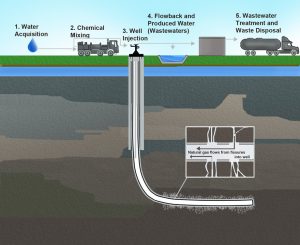 EPA
EPA
The chemicals used in fracking were originally a trade secret, but people talk, and once the word was out, companies like Halliburton published the composition of their fracking liquids. Turns out 90 percent of the frack is made up of water, 9.5 percent consists of a proppant which is usually sand, and only 0.5 percent consists of the scary chemicals often used to undermine the industry. The sand serves as a support to keep the fractures (caused by the pressurized fluid) propped open so gas and/or oil will flow. I am not going to pull punches here. It takes a lot of water to frack a well. Sernovitz estimates that a typical frack (an average of 22 stages) uses between 4 and 8 million gallons of water and about 6 million pounds of sand. Unfortunately, not all of the fracking fluid stays in the hole. Some resurfaces. Today the water that comes back is reused or disposed of by pumping it into former producing fields in a concerted effort to make sure the chemicals within the water (even if they are only 0.5%) are placed out of harms way.
It has been widely reported that fracking causes earthquakes. Actually the disposal of water being pumped into the ground (usually from fracking) causes the seismic activity. Perhaps it seems like a trivial difference, but the public seems to have the idea that the pressure from fracking is so great that it directly causes earthquakes. The typical increase in seismic activity in a state like Oklahoma is usually effectively mitigated by diverting the injection of water from fields responsible for the activity or requiring the water to be disposed of via other methods. There can be little doubt that the earthquakes are associated with well injection and regulatory commissions need to fully address the problems.
The HBO premier of Gasland, a 2010 documentary about the natural-gas industry in general and fracking in particular, was probably responsible, at least in part, for New York State banning fracking and a great deal of misunderstanding about natural gas and its impact on the environment. I have two conflicting opinions about the documentary by Josh Fox. 1) It is clearly tarnished with misrepresented science, almost hysterical overreaction, and historical inaccuracies. The documentary has been thoroughly taken to task by Energy in Depth. 2) Having said that, there is no question that it is emotionally moving. It was difficult to watch people whose lives have been impacted badly by the failures of the gas industry. My conclusion — Gasland was necessary to open a national debate about the issue which has led to more government oversight and less rogue shortcuts leading to serious problems. However although there will always be problems associated with any industry, drilling for natural gas and/or oil on land in the United States is relatively safe to groundwater. We simply have to make sure that casing practices are properly implemented. Water taps catching fire in Dimock, Pennsylvania, happened because of sloppy cement work and poor casing in 27 holes during the early days of drilling in the State (gas leaked through the casing into the surrounding water table). I find it reprehensible that companies would not protect the water table at all costs and fully agree that the companies cited deserve the penalties they received and payouts they had to make to people they injured.
Finally, I need to emphasize that in 2015 the Environmental Protection Agency (EPA) did a summary paper entitled Assessment of the potential impacts of hydraulic fracturing for oil and gas on drinking water resources and concluded that “Assessment shows hydraulic fracturing activities have not led to widespread, systemic impacts to drinking water resources”. We can conclude that the gas industry has made mistakes, but we cannot contend that our drinking water is in danger because of fracking despite claims to the contrary in sources like Gasland.
Let’s not forget why Fox started filming the documentary – to protect his vacation home in a pristine part of Pennsylvania near the border with New York. I get it. No one wants a drill rig in their back yard even if it is only there for 40-days worth of drilling. By the way, if you want to read a reasoned and enlightening book about how people are affected adversely by drilling, I recommend Seamus McGraw’s The End of Country: Dispatches from the Frack Zone3. He weighs the potentially bad impacts of drilling with a healthy dose of understanding that gas and oil companies are filling a demand created by the United States and other world consumers. Unfortunately, Fox never examines the financial impacts of shutting down the fracking industry.
I recently wrote an article on the serious implications of global warming particularly related to the increase of athropogenic gases in our atmosphere. Of the three major fossil fuels, coal is, by far, the worst polluter of carbon dioxide followed by petroleum. Natural gas is the least (see figure below showing the effects of anthropogenic gases as radiative forcing). In fact, Sernovitz has emphasized that “the United States has led the world in carbon dioxide emissions reduction because of shale gas [use of methane gas instead of coal]”.
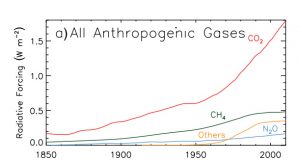
IPCC Fifth Assessment Report 2013
It would be unfair not to point out that methane leaks into the atmosphere directly from the production of methane gas contributing to anthropogenic gases (as methane) also, but according to the EPA in a report entitled Overview of Greenhouse Gases: “Methane (CH4) emissions in the United States decreased by 6% between 1990 and 2014.” During the period from 2007 to 2014, natural gas production was increased tenfold according to the US Energy Information Administration database. The EPA goes on to comment that “During this time period [1990 to 2014], emissions increased from sources associated with agricultural activities, while emissions decreased from sources associated with the exploration and production of natural gas and petroleum products.” Note the lack of effect from the natural gas boom between 2007 to 2014 in the graph below showing total United States methane emissions (converted to carbon dioxide equivalents). In a paper funded by the green-friendly Environmental Defense Fund (EDF) and published in the Proceedings of the National Academy of Science, Allen et. al4 estimated from measuring 190 onshore gas locations that about 0.42 percent of the methane produced leaks from drilling and completion of the wells. The EPA is working with the gas companies to further reduce this figure but, once again, it is hardly having the impact sources such as Gasland have portrayed.
The oil production in thousands of barrels per day since 1966 from the top ten oil producing countries (as of 2015) is shown in the diagram below. One of the most startling aspects of the graph is that the United States has become the World’s largest producer of oil. It’s not Saudia Arabia or Russia, it’s the United States. What is even more remarkable is that our world lead came through good old fashion American know how — the technology that enabled the United States’ producers to frack horizontally. I am no flag waver, but there is no denying how the United States has transformed itself. The halcyon days of the 1960s when the United States led production worldwide were thought to be gone forever (see figure). By the early 1980s, even secondary recovery processes in declining oil fields could not up American production. Our decline in oil production continued until about 2005 when fracking began to be felt. The dramatic impact of that technology can be seen by the subsequent rise in production for the last 10 years in the graph below. However, our increased production does not meet our ever-increasing demand, but it not only helps our trade deficit but decreases our dependence on oil from the troubled Middle East and a hostile Russia. Along with the increase in oil production, we have also become the world’s leader in the production of natural gas (don’t forget that both oil and natural gas have less impact on climate change than coal).
I asked Gary Sernovitz what he thought about America’s new role as a leading oil and natural gas producer: “One of the strange things about the gas boom is that even as prices have gone down, and activity has gone down (because of low prices), volumes have still gone up—a credit to how productive have been [sic] the wells in the Northeast US. This year [2016] gas production is down slightly, but we’re still producing 34% more than the Russians so no risk of losing our crown. 2015 was the year that we exceeded Saudi Arabia in total oil production, and became the world’s largest oil producer. We’ve temporarily lost that crown in 2016, but I’d expect [our] prices to recover for that leadership to happen again soon. And I do think we’re still by far the largest oil and gas producer, despite the dip in oil production because of prices, as we’re far ahead of Russia on oil now too.”
So I would like to summarize the article by stating categorically that we need to curb anthropogenic gasses (carbon dioxide, methane, etc.). But attempting to shut down the oil and gas industry in the United States because of fracking and/or to solve the climate change problem is like trying to take out a drug cartel to stop drug usage in the United States. The only way we are going to reduce our dependency on oil and gas is to reduce the increasing need for it. Fracking is relatively safe to the consumer and looks to be giving America another chance to remain less dependent on other suppliers while we find alternative sources to replace or at least curb America’s craving for energy.
- Margonelli, L. (2007) Oil on the Brian: Adventures from the Pump to the Pipeline: Doubleday ↩
- Sernovitz, G. (2016) The Green and the Black: The Complete Story of the Shale Revolution, the Fight over Fracking, and the Future Energy: St. Martin’s Press ↩
- McGraw, S. (2011) The End of Country: Dispatches from the Frack Zone: Random House ↩
- Allen, D. T. et. al (2013) Measurements of methane emissions at natural gas production sites in the United States: Proceedings of the Natl. Acad. Science: 110, 17768–17773 ↩
Last summer I attended the annual fourth of July parade in our local town with my family. We enjoy watching the floats, pageantry (I am embellishing a bit here), and the copious quantities of candy thrown at us. Nearly every local business has a float — well a truck with the company name on it serves as a float in many instances. The local politicians, constabulary, high-school marching bands, queens of various vegetable festivals, local junior baseball teams, etc. join the queue. The obligatory paper advertisements are handed out by the business participants lauding their merchandise.
During the parade, I had a paper shoved in my face about the problems with genetically modified organisms (GMOs). I had just heard a wonderful Ted talk about how safe GMOs were by genetic scientist Pamela Ronald so the proclamation caught my attention. I realized that the polemic was being passed out by a local health-food store. There was an obvious conflict of interest – by creating suspicions that GMOs were unhealthy or even harmful the store benefited by encouraging people to buy the non GMOs they sold. Disinformation to make a buck? The World Health Organization, the United Nations Development Programme, National Academy of Sciences (US), American Medical Association, American Association for the Advancement of Science, Food and Drug Administration, American Cancer Society, and more than 270 other prestigious groups including many Academy of Sciences in other countries have gone on record through numerous reports that GMOs are safe.
I spent a bit of time in my last essay on global warming bemoaning how the subject has become a political hot potato because of disinformation by Exxon (and I mentioned other examples such as Big Tobacco, the National Football League with concussions, and creationists). Was the radical left on a disinformation campaign also? It certainly appears so. As a scientist I know how difficult it is to achieve a consensus on a hypothesis. Scientists have no time for unsupported opinions – they demand empirically supported results. I don’t deny that politics plays a role, but I like to think, at the end of the day, that the accepted theories that make it through the labyrinth of scientific scrutiny are extremely sound. Let’s not forget that scientists have egos and you get intellectual brownie points for debunking someone’s work. It’s a jungle out there as I have discovered first hand as a research professor. When I see the community of scientists fundamentally agreeing on a topic, I find it fairly convincing (scientists agreeing is an amazing thing in itself). I don’t mean to imply that science cannot make mistakes – there are some notorious examples. But I cannot think of a better way to make educated decisions – based on the research from the experts in the scientific community. Unsupported opinions just don’t cut it even if the people are well meaning.
The case of Golden Rice demonstrates the horrendous impact anti-GMO groups can have in a rush to prevent GMOs from reaching the marketplace1. According to Scientific American Golden Rice had passed the health and safety issues for commercial use by 2002. Syngenta had genetically engineered Vitamin A from corn (beta-carotine) into rice. Syngenta altruistically turned over all the monetary interests for the use of the rice to a non-profit organization to avoid any interference from anti-GMO groups that fight biotech companies for profiting on GMOs. The only hurdle left was regulatory approval. In 2015, Golden Rice was among seven products that won the Patents for Humanity award, but the rice is still not in use anywhere (The Golden Rice Now advocacy group tells me that the Philippines and Bangladesh are expected to have Golden Rice available in 12 months – some time in the middle of 2017). Amazingly, the life-saving rice is strenuously opposed by environmental and anti-globalization activists who object to GMOs.
 International Rice Research Institute (IRRI)
International Rice Research Institute (IRRI)
In 2014, Justus Wesseler of the Technische Universität München and David Zilberman of the University of California quantified the economic impact caused by the resistance2. They estimate that at least $199 million dollars were lost per year over the previous decade just in India. They likened the loss to a metric called life years which they calculated to be 1.4 million in India alone which reflects deaths, blindness and related health disabilities from not having access to Vitamin A. Unfortunately children are the hardest hit.
I want to emphasize that the Golden Rice case is more than a battle over perceived danger by the anti-GMO movement in the face of contrary scientific evidence. There are people dying while Greenpeace, the Sierra Club, and other misguided organizations wage war over unclear principles and leftists ideals. And of course there is always the Non-GMO Project which was created by health-food retailers to sow seeds of doubt (I don’t know if the pun was intended or not) “who oppose a technology that just happens to threaten their profits” according to Scientific American. I should make it clear that my criticism of Greenpeace and the Sierra Club is not done lightly. They serve a real purpose in helping to preserve our environment. But when the science argues against them and lives are at stake, we need to bring them to task. Let me dive into the science that argues against radical and mindless battles over GMOs.
The National Academy of Sciences has just released a consensus 407-page report entitled Genetically Engineered Crops: Experiences and Prospects which reviewed decades of research on genetically engineered (GE) crops. Their conclusions find that GE crops are economically beneficial, safe for humans and livestock, and have adequate regulation. The data is overwhelming impressive and I will take the time to summarize some of the major points.
Humans have been modifying crops for 10,000 years. A good example is the domestication of maize in Meso-America. Teosinite, shown in the left of the diagram below, is a grass that went through a series of human selections of rare mutations to develop modern-day maize grown throughout the world (shown in the right part of the diagram). The point is that humans have been modifying crops through selection of beneficial traits for millennia.
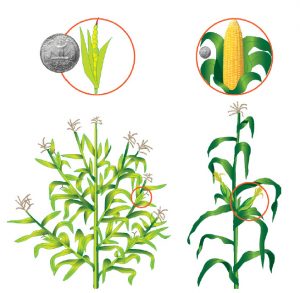 NAS
NAS
In 1985, the United States was the first country to approve a GE crop, and by 1994 a GE tomato, which delayed ripening, was produced for sale. Through 2015 about 12 percent of the land available for crop production contains GE crops (the number goes to 50% in the US). The figure below shows which GE crops are currently being produced and where. Europe, Russia, and most of Africa have been particularly resistant to GE crops as you can see from the map.
 NAS
NAS
There are three major types of GE crops: 1) Herbicide resistant traits which allow the crop to survive herbicide application to kill weeds or insects. 2) Insect resistant traits which typically incorporate a gene code from Bacillum thuringiensis (Bt) to the crop, killing insects when they feed on the plant. 3) Virus resistant traits which keep the plants from being susceptible to specific plant viruses. It is important to note that most of the crops are modified to resist one insect, virus, or herbicide. Drought tolerance, nonbrowning (e.g., with potatoes and apples), various colors in flowers, stability of oil to suppress trans-fats, enhancement of omega-3 fatty acids are other examples of GE traits in commercial production.
The NAS report reviews studies conducted comparing the production of GE crops to non-GE crops in mind-numbing detail. But some clear important conclusions have been summarized below (I quote to avoid any misrepresentation of the information). Please note that I have not included all the findings because many are quite esoteric. I refer the reader to the NAS report for more details.
- “Although results are variable, Bt traits available in commercial crops from introduction in 1996 to 2015 have in many locations contributed to a statistically significant reduction in the gap between actual yield and potential yield when targeted insect pests caused substantial damage to non-GE varieties and synthetic chemicals did not provide practical control.” Potential yield is the theoretical yield a crop could achieve if water and other nutrients are in adequate supply and there are no losses to pests and disease.
- “In areas of the United States where adoption of Bt maize or Bt cotton is high, there is statistical evidence that insect-pest populations are reduced regionally, and the reductions benefit both adopters and nonadopters of Bt crops.”
- “In all cases examined, use of Bt crop varieties reduced application of synthetic insecticides in those fields. In some cases, the use of Bt crop varieties has also been associated with reduced use of insecticides in fields with non-Bt varieties of the crop and other crops.”
- “The widespread deployment of crops with Bt toxins has decreased some insect-pest populations to the point where it is economically realistic to increase plantings of crop varieties without a Bt toxin that targets these pests. Planting varieties without Bt under those circumstances would delay evolution of resistance further.”
- “Planting of Bt varieties of crops tends to result in higher insect biodiversity than planting of similar varieties without the Bt trait that are treated with synthetic insecticides.”
- “Although gene flow has occurred, no examples have demonstrated an adverse environmental effect of gene flow from a GE crop to a wild, related plant species.”
- “Crop plants naturally produce an array of chemicals that protect against herbivores and pathogens. Some of these chemicals can be toxic to humans when consumed in large amounts.” I emphasized naturally here because the statement pertains to the production of chemicals by non-GE crops.
- “Conventional breeding and genetic engineering can cause unintended changes in the presence and concentrations of secondary metabolites.” This is not only important but emphasizes the need for oversight in the approval of GE crops. However, NAS also concluded: “U.S. regulatory assessment of GE herbicide-resistant crops is conducted by USDA, and by
FDA when the crop can be consumed, while the herbicides are assessed by EPA when there are new potential exposures.” - Regarding safety, NAS concluded: “In addition to experimental data, long-term data on the health and feed-conversion efficiency of livestock that span a period before and after introduction of GE crops show no adverse effects on these measures associated with introduction of GE feed. Such data test for correlations that are relevant to assessment of human health effects, but they do not examine cause and effect.” In others words, GE crops appear to be safe for the animals that consume them and for humans that consume either these animals or the GE crops directly.
- “The incidence of a variety of cancer types in the United States has changed over time, but the changes do not appear to be associated with the switch to consumption of GE foods. Furthermore, patterns of change in cancer incidence in the United States are generally similar to those in the United Kingdom and Europe, where diets contain much lower amounts of food derived from GE crops. The data do not support the assertion that cancer rates have increased because of consumption of products of GE crops.”
- “The committee found no published evidence to support the hypothesis that the consumption of GE goods has caused higher U.S. rates of obesity or type II diabetes.”
- “The committee could find no published evidence supporting the hypothesis that GE foods generate unique gene or protein fragments that would affect the body.”
- “The committee did not find a relationship between consumption of GE foods and the increase in prevalence of food allergies.”
- “The similarity in patterns of increase in autism spectrum disorder in children in the United States, where GE foods are commonly eaten, and the United Kingdom, where GE foods are rarely eaten, does not support the hypothesis of a link between eating GE foods and prevalence of autism spectrum disorder.”
- “On the basis of its understanding of the process required for horizontal gene transfer from plants to animals and data on GE organisms, the committee concludes that horizontal gene transfer from GE crops or conventional crops to humans does not pose a substantial health risk.”
- “The available evidence indicates that GE soybean, cotton, and maize have generally had favorable outcomes in economic returns to producers who have adopted these crops, but there is high heterogeneity in outcomes.”
- “Exploitation of inherent biological processes—DNA binding-zinc finger proteins (ZFNs), pathogen-directed transcription of host genes (TALEs), and targeted degradation of DNA sequences (CRISPR/Cas)—now permit precise and versatile manipulation of DNA in plants.”
- “New molecular tools are further blurring the distinction between genetic modifications made with conventional breeding and those made with genetic engineering.”
- “Treating genetic engineering and conventional breeding as competing approaches is a false dichotomy; more progress in crop improvement could be brought about by using both conventional breeding and genetic engineering than by using either alone.”
- “In some cases, genetic engineering is the only avenue for creating a particular trait. That should not undervalue the importance of conventional breeding in cases in which sufficient genetic variation is present in existing germplasm collections, especially when a trait is controlled by many genes.”
- “Although genome editing is a new technique and its regulatory status was unclear at the time the committee was writing this report, the committee expects that its potential use in crop improvement in the coming decades will be substantial.” I think this is an extremely important conclusion. If we want to continue to feed the world we are probably going to become more dependent on GE crops particularly if population continues to increase at present rates.
- “Genetic engineering can be used to develop crop resistance to plant pathogens with potential to reduce losses for farmers in both developed and developing countries.”
- “Genetic engineering can enhance the ability to increase the nutritional quality and decrease antinutrients of crop plants.”
- There are similar accounts of environmental groups shutting down a genetically modified eggplant in India, Bangladesh, and the Philippines. Another involved a genetically modified potato which was resistant to specific herbicides. A large food chain under pressure from environmental groups refused to purchase genetically modified potatoes and the project was shut down. Farmers then introduced a new herbicide for the non-genetically modified potatoes grown instead ↩
- Wesseler, J. and Zilberman, D. (2014) The economic power of the Golden Rice opposition: Environmental and Development Economics: 19, 724-742 ↩
Disinformation has become a hallmark of companies and religious sects interested in undermining science. Please note that I have used disinformation instead of misinformation because these organizations have purposefully spread wrong or bad information to mislead the public and cloud issues discovered by science. The most famous example comes from the tobacco industry. Richard Kluger’s book Ashes to Ashes1 won the Pulitzer prize and helped expose the ruse that nicotine is not harmful or addictive. The tobacco industry funded hundreds of scientific research projects in an attempt to muddy the waters concerning the health risks of smoking. Who will ever forget the seven CEOs of America’s largest tobacco companies swearing in front of Congress in 1994 that nicotine is not addictive (still on Youtube if you care to reminisce). One of the leading examples of the travesty was the funding of the Harvard Center for Tobacco Research. Big Tobacco, through its Council for Tobacco Research, gave millions of dollars to the Center and Dr. Gary Huber2
In a more recent exposé, Mark Fainaru-Wada and Steve Fainaru showed in their book League of Denial how the National Football League actively downplayed the seriousness of trauma to the head3. For example, to offset concern over head injuries, the NFL and commissioner Paul Tagliabue set up the Mild Traumatic Brain Injury Committee (MTBI) in 1994. The committee was notorious for denying that concussions did not lead to serious effects. In 2003, the committee began publishing what would amount to 16 research papers in the coopted science journal Neurosurgery, supporting their contention that the concussion problem was minor. It certainly helped that the Neurosurgery editor, Michael L. J. Apuzzo, was a major NFL fan4. The MTBI fuzzy logic included statements such as: “A total of 92% of concussed players returned to practice in less than seven days … More than one-half of the players returned to play within one day, and symptoms resolved in a short time in the vast majority of cases.” During the same period independent research was discovering chronic traumatic encephalopathy (CTE) in the brains of deceased football players that had suffered numerous concussions throughout their careers.
Then there is the whole creationist movement which has attempted to undermine science through such organizations as the Institute for Creation Research. There is neither space nor time to delve into the movement’s attempts to promote creationism and more recently intelligent design. If you want to read a riveting account of one of the recent battle fronts pick up a copy of Monkey Girl by Edward Humes5. It documents the attempt by the Dover School Board to demand the teaching of intelligent design in science classes which resulted in Kitzmiller v. Dover Area School District legal brouhaha.
Does this sound familiar? Exxon (now ExxonMobile) formed the Global Climate Coalition in the 1980s to lobby congress and actively dispute the claim that global warming was not caused by anthropic greenhouse gases6. The organization shut down in 2001 under pressure from numerous groups, but by then, the term global warming had morphed into a political issue entrenched in right-wing politics. But the time may be coming for ExxonMobile to pay up for its disinformation campaign. More than a dozen state attorney generals are investigating ExxonMobile for attempting to obfuscate the facts about global warming. The New York Times reported in March that new documents published by the activist group Center for International Environmental Law shows that Exxon knew about the dangers of global warming from carbon dioxide through its own research as far back as 1957 and established a campaign that doggedly fought air pollution control.
Admittedly, politics always baffles me. The science of global warming via anthropic greenhouse gases seems so obvious that I have trouble seeing how the issue could become such a heated-cantankerous argument. Let me briefly outline the science and you decide. I have no ax to grind in the debate. I tend to favor middle of the road solutions. What I am more interested in is how the issue could ever become hijacked by politics. If you are the kind of person whose eyes glaze over when you see graphs, hang in there because it is all pretty straight forward. Before we dig in, let me remind you of a phrase Thomas Henry Huxley, known as Darwin’s bulldog, said: “My business is to teach my aspirations to conform themselves to fact, not to try and make facts harmonize with my aspirations… Sit down before fact as a little child, be prepared to give up every preconceived notion, follow humbly wherever and to whatever abysses nature leads, or you shall learn nothing.”
Wavelength is plotted below on the x-axis (which is broken down into UV, visible, and infrared radiation) and the spectral intensity is plotted on the y-axis. The red curve (top panel) represents the span of wavelengths transmitted by the sun and received at the top of the earth’s atmosphere. Scientists refer to the electromagnetic radiation that comes from the sun as Planck black body radiation because they can reproduce it by heating an opaque non-reflective body (a black body) to a temperature of 5,525 degrees Kelvin. The red region represents the extent of radiation that is received at the earth’s surface (i.e., not absorbed). Note that most of the UV radiation is absorbed by the atmosphere (mostly due to the ozone layer fortunately) and most of the visible spectrum gets through. Animals have evolved to “see” in the visible spectrum almost certainly because light comes to us in this range of the spectrum.
 Global Warming Art, Wikipedia
Global Warming Art, Wikipedia
The average Planck black body radiation of the earth is represented by the blue curve (255 degrees Kelvin)7 The blue area filled in under the blue curve is the amount of radiation from the earth that escapes into space (emitted by the top of the atmosphere) which is equal to about 15 to 30% transmission. Virtually all of the near to far infrared is absorbed by greenhouse gasses shown in the panels in the above diagram for each of the gases. Water plays the biggest role but carbon dioxide has an impact on the far infrared. You can see this better in the diagram below.
 NASA
NASA
Relatively small increases in carbon dioxide have a profound affect on the absorption of radiation (energy). In fact, it is so sensitive that carbon dioxide closely follows the temperature changes during the past glacial cycles — the last 420,000 years are shown below. As you can see, we are in an interglacial warming period and, under normal nonanthropic conditions would expect to enter another ice age in about 10,000 years8. I should mention that carbon dioxide concentrations were measured from Vostock ice cores taken from Antarctica (the ice traps air bubbles locking in atmospheric concentrations). Temperatures in the same cores were determined from hydrogen and oxygen isotopes9 10.
 NASA/NOAA
NASA/NOAA
Now here is one of the most astounding graphs in environmental science – carbon dioxide and temperature over about the last 20,000 years11. It shows global temperature in the blue curve relative to the Holocene mean between 6.5 and 11.5 thousand years ago (LGM is the last glacial maximum). The red curve is an Antarctic composite core temperature profile. Carbon dioxide concentrations (yellow dots) start to rise as we come out of the last glacial cycle along with temperature about 18,000 years ago and continue to rise until about 8,000 years ago when they become stable (temperature – red curve – and carbon dioxide in the cores lag a bit behind global temperature – blue curve). Note that carbon dioxide concentrations have stabilized at about 260 ppm (parts per million) over the last 8,000 years or more (the current carbon dioxide changes are too new to be picked up in the cores).
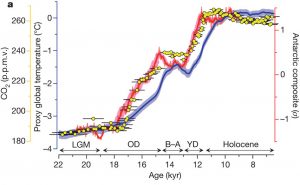 Shakun et al., 2012
Shakun et al., 2012
Compare the graphs above to the carbon dioxide data measured directly from Hawaii since 1957 below. The concentrations went above 400 ppm in 2015 (the annual variations are due to higher output in carbon dioxide by vegetation during the summer in the northern hemisphere – more land in the north), 140 ppm over the average of the last 8,000 years shown in the above diagram. It is important to point out that carbon dioxide concentrations have not reached this level in more than 3 million years12!

And here is why scientists think that humans are responsible for most of the carbon dioxide increase. The graph is of temperature from 1880 (annual mean compared to the average between 1951 to 1980). The red line is a five-year running average. Temperature begins to increase significantly when carbon dioxide concentrations reach about 340 ppm in the mid 1970s. The Intergovernmental Panel on Climate Change won the Nobel Peace Prize in 2007 and consists of thousands of the world’s finest scientific minds contributing to their reports. The IPCC Fifth Assessment Report which was completed in 2014, stated: “It is extremely likely [90 to 100% probability in their words] that human influence has been the dominant cause of observed warming since 1950, with the level of confidence having increased since the fourth report”.
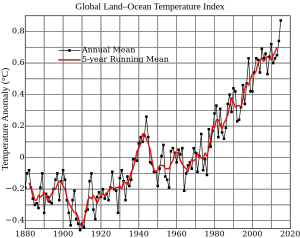 NASA
NASA
So why all the fuss? Even if we admit that carbon dioxide and global temperatures are rising (and they are also rising in the ocean because carbon dioxide and heat are absorbed from the atmosphere), is this devastating for the future of the world? To be honest, no one knows for sure. I could list a plethora of examples of the impact from these changes – sea level rise, species habitats being pushed toward higher latitudes or higher elevations worldwide, ocean acidity, continued melting of the world’s glaciers, etc. But the data that keeps me up at night (being overly dramatic here) is the tipping point. Climate models show global temperatures rising between 1 to 2.5 degrees centigrade (1.8 to 4.5 degrees F) between 2050 and 2100. We don’t know what might throw us into a tipping point – what Wagner and Weitzman call “tail effects” or “black swans” to designate statically low probability extreme events13. They are referred to as tail events because they occur on the ends of a bell distribution curve (less than 2.1% in the figure below – greater than 2 standard deviations). These events will be so potentially horrendous that we may not know how to combat them.
Wagner and Weitzman claim that tail events are “profound earth-as-we-know-it-altering changes”. For example, they may lead to as much as a 30 percent decline in global economic output. No one knows. The only thing that is certain is that if we continue to ignore global warming and its effects, we are taking huge potential risks.
 Wikipedia
Wikipedia
- Kluger, R. (1996) Ashes to Ashes: America’s Hundred-Year Cigarette War, the Public Health, and the Unabashed Triumph of Philip Morris: Vintage ↩
- McGarity, T. O. and Wagner, W. E. (2012) Bending Science: How Special Interests Corrupt Public Health Research: Harvard University Press ↩
- Fainaru-Wada, M. and Fainaru, S. (2013) League of Denial: Three Rivers Press ↩
- Fainaru-Wada and Fainaru suggest that Apuzzo was drawn to the limelight of the NFL as the major reason for allowing dubious papers to be published by the MTBI ↩
- Humes, E. (2007) Monkey Girl: HarperCollins Publishers ↩
- The CCC was a major opponent to the Kyoto Protocol and was instrumental in persuading the US not to sign it ↩
- The black curve is the upper atmosphere at 210 degrees Kelvin and the purple curve is the lower atmosphere near the earth’s surface at 310 degrees Kelvin. ↩
- Novacek, M. (2007) Terra: Our 100-Million-Year-Old Ecosystem — and the Threats That Now Put It at Risk: Farrar, Straus and Giroux ↩
- The ratio of hydrogen isotopes has a linear relationship with temperature. The hydrogen isotope (hydrogen has one electron and deuterium has 2 electrons) is lighter than deuterium and preferentially evaporates relative to deuterium from seawater (it takes less energy to evaporate a water molecule with hydrogen than a molecule with deuterium). In periods of high temperature, more water evaporates concentrating deuterium in seawater relative to the atmosphere. The relationship between hydrogen and deuterium in the atmosphere is recorded in snow as it falls and becomes part of the glacier sampled. Temperatures are extrapolated from the ratio of the isotopes of hydrogen. Oxygen isotopes are used in a similar way to augment the hydrogen isotopes. ↩
- Petit, J. R., et al. (1999) Climate and atmospheric history of the past 420,000 years from the Vostok ice core Antarctica: Nature, 399, 429-436 ↩
- Shakun, J. D., et al. (2012) Global warming preceded by increasing carbon dioxide concentrations during the last glaciation: Nature, 484, 49-54 ↩
- Nordhaus, W. D. (2015) A new solution: the climate club: New York Review of Books, June 4 ↩
- Wagner, G. and Weitzman, M. L. (2015) Climate Shock: The Economic Consequences of a Hotter Planet: Princeton University Press ↩
I can’t rave enough about Jennifer Kahn’s recent TED talk entitled Gene Editing Can Now Change an Entire Species. The talk summarizes the new power of gene drives to eradicate malaria, dengue and yellow fever, and other dangerous diseases spread by insects. It is truly a brave new world. CRISPR (Clustered regularly interspaced short palindromic repeats) is a gene editing tool which allows scientists to edit genes precisely. In Kahn’s phrasing, it is a “word processor for genes”. Gene drives not only use CRISPR technology to edit genes but also include the mechanics of CRISPR in the DNA to enable the new gene to be passed on to offspring.
Among the intriguing uses of the new technology is to potentially rid the planet of invasive species that threaten indigenous ones. A good example is the Asian carp that has invaded our Great Lakes. Incorporate a gene drive in the Asian carp that has it producing only male offspring and within a matter of generations, the Asian carp will be gone. Of course, Kahn gives the necessary genuflections toward the need to come to agreement on the ethical issues involved, but the future applications are breathtaking.
I remember reading the superb book Rat Island by William Stolzenburg1 about the monumental attempts that have taken place, primarily since the 1970s, to eliminate invasive species, particularly on islands. Indigenous species are no match for invasive predators such as rats, feral cats, and a host of other animals that have hitched a ride with humans to these islands. You can imagine why species like the flightless kakapoo, have been decimated or pushed to extinction at the hands of predators these species have been evolutionarily unprepared for.

Kahn makes a great point. Using gene drives to eradicate species may backfire. What if modified Asian carps return to Asia (let’s not forget, they are invasive species)? The gene drive could wipe out the entire Asian carp population worldwide. But the good news is that there is a reversal gene drive which can change the modified carp back to normal should they reach their home territories. I know the new technology will have to go through a myriad of ethical panels and boards but ultimately it may have come just in time to save many species from the finality of extinction via invasive species.
The primary method of killing invasive rats has been through bait laced with Brodifacoum. The poison is an anticoagulant and eventually causes the rat’s blood vessels to “leak” and, after about a week, the animal bleeds out. Studies have shown it is probably a quite painful way to die. As one might imagine, this has caused angst among conservationist. On the one hand they want to return habitats to their pristine beauty, but on the other hand, the death of creatures, even rats, has caused somewhat of a “Sophie’s choice”. The majority of conservationists have come down on the side of eradication in the face of massive island species extinctions. David Steadman of the University of Florida estimated2 that 8,000 populations have disappeared from the islands of Oceania (about 800 islands). Turns out there was an unintended outcome of using these poisons (isn’t there always?). Some birds of prey including the bald eagle were eating the poisoned rats and dying.
Gene drives may be the silver bullet in the eradication of invasive species. Conservationists using the new technology can avoid the need to kill targeted animals. And no bykill! I know, I know, we need to test the process to make sure we avoid all the potential unintended consequences, but even if it is only partially successful, it could be huge for the environment.
I vividly remember reading E. O. Wilson’s The Diversity of Life3 as he detailed the enchanting story of the repopulation of what was left of Krakatoa volcano after it blew itself out of the water in 1883. It is clear that there is a capriciousness to repopulation. Many species find themselves carried or blown to remote islands by currents, storms, and even tsunamis. And in time, they may evolve into new species adapting to the often hostile new environments. But why are these early inhabitants given precedence over late arrivals? It appears to rest on the assumption that humans are unnatural – not part of the natural environment. And therefore, if other animals tag along with us as a human food source for long voyages, or as our pets, or even surreptitiously, they are somehow unnatural in the grander scheme of things, demanding eradication. You cannot read Rat Island and not be repulsed by the way rats prey on other creatures. I am certainly not against the eradication of these invasive species, but it is not an easy thing deciding what lives and dies.
- Stolzenburg, W. (2011) Rat Island: Predators in Paradise and the World’s Greatest Wildlife Rescue: New York, Bloomsbury ↩
- Steadman, D. W. (1995) Prehistoric extinctions of Pacific Island brids: Biodiversity meets zooarchaeology: Science, 267, p. 1123- 1131. ↩
- Wilson, E. O., (1999) The Diversity of Life: W. W. Norton & Company ↩

